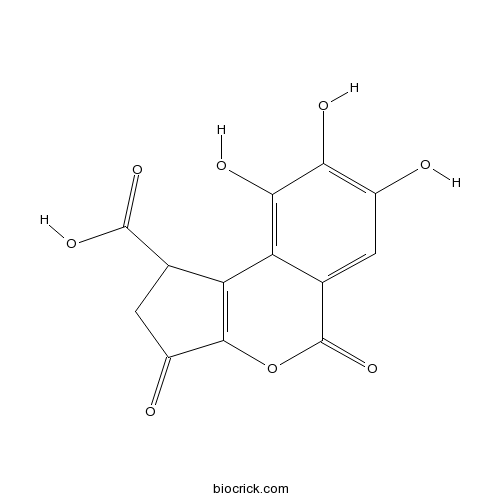Brevifolincarboxylic acidCAS# 18490-95-4 |

Quality Control & MSDS
3D structure
Package In Stock
Number of papers citing our products

| Cas No. | 18490-95-4 | SDF | Download SDF |
| PubChem ID | 9838995 | Appearance | Yellowish powder |
| Formula | C13H8O8 | M.Wt | 292.2 |
| Type of Compound | Phenols | Storage | Desiccate at -20°C |
| Solubility | Soluble in DMSO and water | ||
| Chemical Name | 7,8,9-trihydroxy-3,5-dioxo-1,2-dihydrocyclopenta[c]isochromene-1-carboxylic acid | ||
| SMILES | C1C(C2=C(C1=O)OC(=O)C3=CC(=C(C(=C32)O)O)O)C(=O)O | ||
| Standard InChIKey | JFJWMFPFMLRLMI-UHFFFAOYSA-N | ||
| Standard InChI | InChI=1S/C13H8O8/c14-5-2-4-7(10(17)9(5)16)8-3(12(18)19)1-6(15)11(8)21-13(4)20/h2-3,14,16-17H,1H2,(H,18,19) | ||
| General tips | For obtaining a higher solubility , please warm the tube at 37 ℃ and shake it in the ultrasonic bath for a while.Stock solution can be stored below -20℃ for several months. We recommend that you prepare and use the solution on the same day. However, if the test schedule requires, the stock solutions can be prepared in advance, and the stock solution must be sealed and stored below -20℃. In general, the stock solution can be kept for several months. Before use, we recommend that you leave the vial at room temperature for at least an hour before opening it. |
||
| About Packaging | 1. The packaging of the product may be reversed during transportation, cause the high purity compounds to adhere to the neck or cap of the vial.Take the vail out of its packaging and shake gently until the compounds fall to the bottom of the vial. 2. For liquid products, please centrifuge at 500xg to gather the liquid to the bottom of the vial. 3. Try to avoid loss or contamination during the experiment. |
||
| Shipping Condition | Packaging according to customer requirements(5mg, 10mg, 20mg and more). Ship via FedEx, DHL, UPS, EMS or other couriers with RT, or blue ice upon request. | ||
| Description | 1. Brevifolincarboxylic acid shows marked inhibitory effects on aryl hydrocarbon receptor -based bioassay activation by TCDD, and its effect is dose dependent. 2. Brevifolincarboxylic acid (IC50 = 18.0 uM) shows good antioxidant activity. 3. Brevifolincarboxylic acid shows moderate antibacterial activity against Salmonella enteritidis , Salmonella typhimurium , and Salmonella abony. |
| Targets | Antifection |

Brevifolincarboxylic acid Dilution Calculator

Brevifolincarboxylic acid Molarity Calculator
| 1 mg | 5 mg | 10 mg | 20 mg | 25 mg | |
| 1 mM | 3.4223 mL | 17.1116 mL | 34.2231 mL | 68.4463 mL | 85.5578 mL |
| 5 mM | 0.6845 mL | 3.4223 mL | 6.8446 mL | 13.6893 mL | 17.1116 mL |
| 10 mM | 0.3422 mL | 1.7112 mL | 3.4223 mL | 6.8446 mL | 8.5558 mL |
| 50 mM | 0.0684 mL | 0.3422 mL | 0.6845 mL | 1.3689 mL | 1.7112 mL |
| 100 mM | 0.0342 mL | 0.1711 mL | 0.3422 mL | 0.6845 mL | 0.8556 mL |
| * Note: If you are in the process of experiment, it's necessary to make the dilution ratios of the samples. The dilution data above is only for reference. Normally, it's can get a better solubility within lower of Concentrations. | |||||

Calcutta University

University of Minnesota

University of Maryland School of Medicine

University of Illinois at Chicago

The Ohio State University

University of Zurich

Harvard University

Colorado State University

Auburn University

Yale University

Worcester Polytechnic Institute

Washington State University

Stanford University

University of Leipzig

Universidade da Beira Interior

The Institute of Cancer Research

Heidelberg University

University of Amsterdam

University of Auckland

TsingHua University

The University of Michigan

Miami University

DRURY University

Jilin University

Fudan University

Wuhan University

Sun Yat-sen University

Universite de Paris

Deemed University

Auckland University

The University of Tokyo

Korea University
- 5-Benzyl-1H-tetrazole
Catalog No.:BCC8741
CAS No.:18489-25-3
- NNC 05-2090 hydrochloride
Catalog No.:BCC7472
CAS No.:184845-18-9
- 1,3,6-Tri-O-galloylglucose
Catalog No.:BCN8227
CAS No.:18483-17-5
- Chlorhexidine digluconate
Catalog No.:BCC5264
CAS No.:18472-51-0
- Delta 5-avenasterol
Catalog No.:BCN3211
CAS No.:18472-36-1
- Nortropacocaine
Catalog No.:BCN1889
CAS No.:18470-33-2
- Sodium houttuyfonate
Catalog No.:BCN2978
CAS No.:1847-58-1
- NAD 299 hydrochloride
Catalog No.:BCC6003
CAS No.:184674-99-5
- Pelargonidin-3-O-glucoside chloride
Catalog No.:BCN3113
CAS No.:18466-51-8
- 2-C-Methyl-D-erythrono-1,4-lactone
Catalog No.:BCN4769
CAS No.:18465-71-9
- Nigracin
Catalog No.:BCN1152
CAS No.:18463-25-7
- Ethyl Coumarin-3-Carboxylate
Catalog No.:BCC9228
CAS No.:1846-76-0
- Liquidambaric lactone
Catalog No.:BCN2301
CAS No.:185051-75-6
- R 715
Catalog No.:BCC6014
CAS No.:185052-09-9
- Decoquinate
Catalog No.:BCC4654
CAS No.:18507-89-6
- Ethyl 1,2,5,6-tetrahydropyridine-3-carboxylate
Catalog No.:BCC8299
CAS No.:18513-76-3
- Chrysin 6-C-arabinoside 8-C-glucoside
Catalog No.:BCN1517
CAS No.:185145-33-9
- Chrysin 6-C-glucoside 8-C-arabinoside
Catalog No.:BCN1516
CAS No.:185145-34-0
- Butabindide oxalate
Catalog No.:BCC7020
CAS No.:185213-03-0
- Scabertopin
Catalog No.:BCN4685
CAS No.:185213-52-9
- Loganin
Catalog No.:BCN1153
CAS No.:18524-94-2
- Ceplignan
Catalog No.:BCN3626
CAS No.:185244-78-4
- Rp-8-Br-PET-cGMPS
Catalog No.:BCC7538
CAS No.:185246-32-6
- GR 46611
Catalog No.:BCC5679
CAS No.:185259-85-2
Screening of the inhibitory effect of vegetable constituents on the aryl hydrocarbon receptor-mediated activity induced by 2,3,7,8-tetrachlorodibenzo-p-dioxin.[Pubmed:14646185]
Biol Pharm Bull. 2003 Dec;26(12):1754-60.
The aryl hydrocarbon receptor (AhR) is a ligand-activated nuclear transcription factor that mediates responses to environmental contaminants such as dioxins, which have many adverse health effects. We performed a preliminary screening of the inhibitory effects of vegetable constituents on 2,3,7,8-tetrachlorodibenzo-p-dioxin (TCDD)-induced activation of AhR using the AhR-based bioassay for dioxins, the Ah-Immunoassay. Ninety vegetable constituents including flavonoids, tannins, saponins, terpenes, etc., were assayed in vitro. Among them, flavones, flavonols, anthraquinones, piperine, coumestrol, Brevifolincarboxylic acid, and resveratrol showed marked inhibitory effects on AhR-based bioassay activation by TCDD, and their effects were dose dependent. Curcumin, carnosol, and capsaicin also inhibited the activation of AhR in this assay, although to a lesser degree. These results suggest that several vegetable constituents might play a role in protection against dioxin toxicity.


